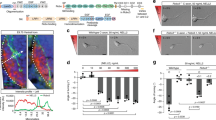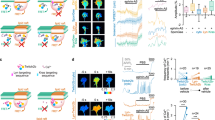Abstract
The UNC-5 receptor mediates axon repulsion from UNC-6/netrin through UNC-40 dependent (UNC-5 + UNC-40) and independent (UNC-5 alone) signaling pathways. It has been shown that UNC-40–dependent signaling is required for long-range repulsion of UNC-6/netrin; however, the mechanisms used to regulate distinct UNC-5 signaling pathways are poorly understood. We found that the C. elegans transforming growth factor β (TGF-β) family ligand UNC-129, graded opposite to UNC-6/netrin, functions independent of the canonical TGF-β receptors to regulate UNC-5 cellular responses. Our observations indicates that UNC-129 facilitates long-range repulsive guidance of UNC-6 by enhancing UNC-5 + UNC-40 signaling at the expense of UNC-5 alone signaling through interaction with the UNC-5 receptor. This increases the set point sensitivity of growth cones to UNC-6/netrin as they simultaneously migrated up the UNC-129 gradient and down the UNC-6 gradient. Similar regulatory interactions between oppositely graded extracellular cues may be a common theme in guided cell and axon migrations.
This is a preview of subscription content, access via your institution
Access options
Subscribe to this journal
Receive 12 print issues and online access
$209.00 per year
only $17.42 per issue
Buy this article
- Purchase on Springer Link
- Instant access to full article PDF
Prices may be subject to local taxes which are calculated during checkout





Similar content being viewed by others
References
Chilton, J.K. Molecular mechanisms of axon guidance. Dev. Biol. 292, 13–24 (2006).
Colavita, A. & Culotti, J.G. Suppressors of ectopic UNC-5 growth cone steering identify eight genes involved in axon guidance in Caenorhabditis elegans. Dev. Biol. 194, 72–85 (1998).
Colavita, A., Krishna, S., Zheng, H., Padgett, R.W. & Culotti, J.G. Pioneer axon guidance by UNC-129, a C. elegans TGF-beta. Science 281, 706–709 (1998).
Hedgecock, E.M., Culotti, J.G. & Hall, D.H. The unc-5, unc-6 and unc-40 genes guide circumferential migrations of pioneer axons and mesodermal cells on the epidermis in C. elegans. Neuron 4, 61–85 (1990).
Qin, H. & Powell-Coffman, J.A. The Caenorhabditis elegans aryl hydrocarbon receptor, AHR-1, regulates neuronal development. Dev. Biol. 270, 64–75 (2004).
Keleman, K. & Dickson, B.J. Short- and long-range repulsion by the Drosophila Unc5 netrin receptor. Neuron 32, 605–617 (2001).
Ikegami, R., Zheng, H., Ong, S.H. & Culotti, J.G. Integration of semaphorin-2A/MAB-20, ephrin-4 and UNC-129 TGF-beta signaling pathways regulates sorting of distinct sensory rays in C. elegans. Dev. Cell 6, 383–395 (2004).
Hamelin, M., Zhou, Y., Su, M.W., Scott, I.M. & Culotti, J.G. Expression of the UNC-5 guidance receptor in the touch neurons of C. elegans steers their axons dorsally. Nature 364, 327–330 (1993).
Merz, D.C., Zheng, H., Killeen, M.T., Krizus, A. & Culotti, J.G. Multiple signaling mechanisms of the UNC-6/netrin receptors UNC-5 and UNC-40/DCC in vivo. Genetics 158, 1071–1080 (2001).
Barrios-Rodiles, M. et al. High-throughput mapping of a dynamic signaling network in mammalian cells. Science 307, 1621–1625 (2005).
Koenig, B.B. et al. Characterization and cloning of a receptor for BMP-2 and BMP-4 from NIH 3T3 cells. Mol. Cell. Biol. 14, 5961–5974 (1994).
Keller, S., Nickel, J., Zhang, J.L., Sebald, W. & Mueller, T.D. Molecular recognition of BMP-2 and BMP receptor IA. Nat. Struct. Mol. Biol. 11, 481–488 (2004).
Guirland, C., Suzuki, S., Kojima, M., Lu, B. & Zheng, J.Q. Lipid rafts mediate chemotropic guidance of nerve growth cones. Neuron 42, 51–61 (2004).
Augsburger, A., Schuchardt, A., Hoskins, S., Dodd, J. & Butler, S. BMPs as mediators of roof plate repulsion of commissural neurons. Neuron 24, 127–141 (1999).
Dillon, A.K. et al. UNC5C is required for spinal accessory motor neuron development. Mol. Cell. Neurosci. 35, 482–489 (2007).
Brenner, S. The genetics of Caenorhabditis elegans. Genetics 77, 71–94 (1974).
Chan, S.S. et al. UNC-40, a C. elegans homolog of DCC (deleted in colorectal cancer), is required in motile cells responding to UNC-6 netrin cues. Cell 87, 187–195 (1996).
Tong, J. et al. Netrin stimulates tyrosine phosphorylation of the UNC-5 family of netrin receptors and induces Shp2 binding to the RCM cytodomain. J. Biol. Chem. 276, 40917–40925 (2001).
Frolik, C.A., Wakefield, L.M., Smith, D.M. & Sporn, M.B. Characterization of a membrane receptor for transforming growth factor–beta in normal rat kidney fibroblasts. J. Biol. Chem. 259, 10995–11000 (1984).
Sambrook, J., Fritsch, E.F. & Maniatis, T. Molecular Cloning: A Laboratory Manual (Cold Spring Harbor Press, Cold Spring Harbor, New York, 1989).
Acknowledgements
We would like to thank K. Fujisawa, T. Kawano, R. Steven and C. LeRoy for helpful discussions, L. Brown for help with microscopy, M. Barrios-Rodiles for help with luciferase assays, and S. Suo and J. Plummer for careful reading of the manuscript. Funding for this work was provided by grants from the US National Institutes of Health (NS41397 to J.G.C.), the Canadian Institutes of Health Research (12860 to J.L.W. and GSP36651 to T.P.), the Canadian Institutes of Health Research Barbara Turnbull award (MOP77722 to J.G.C.) and the Cancer Research Society of Canada (L.T.M.). J.L.W. and J.G.C. are Canada Research Chairs. T.P. is a Distinguished Scientist of the Canadian Institutes of Health Research. J.L.W. is a Howard Hughes Medical Institute international scholar.
Author information
Authors and Affiliations
Contributions
W.R.H. made the UNC-5–HA and Gluc–UNC-129 constructs. L.T.M. and W.R.H. caried out the luciferase assays. All other experiments were performed by L.T.M. J.L.W. and J.G.C. supervised the project. T.P. provided reagents. L.T.M., J.L.W. and J.G.C. wrote the manuscript.
Corresponding author
Supplementary information
Supplementary Text and Figures
Supplementary Figures 1–3 and Supplementary Methods (PDF 724 kb)
Rights and permissions
About this article
Cite this article
MacNeil, L., Hardy, W., Pawson, T. et al. UNC-129 regulates the balance between UNC-40 dependent and independent UNC-5 signaling pathways. Nat Neurosci 12, 150–155 (2009). https://doi.org/10.1038/nn.2256
Received:
Accepted:
Published:
Issue Date:
DOI: https://doi.org/10.1038/nn.2256



